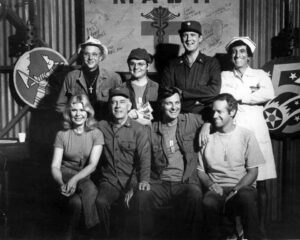The casting process of MAS*H stands as one of the most intriguing chapters in television history. This groundbreaking series, which ran from 1972 to 1983, didn’t just happen by accident. Behind every memorable character was a complex selection process filled with surprising choices, near-misses, and serendipitous discoveries that shaped the show into the cultural phenomenon we remember today.
- The Search for Hawkeye Pierce
When producers began casting for the role of Captain Benjamin Franklin “Hawkeye” Pierce, they faced an enormous challenge. The character needed to embody both comedic brilliance and dramatic depth, someone who could deliver witty one-liners while conveying the emotional weight of war. Alan Alda wasn’t the obvious choice initially. The studio wanted a bigger name, someone with more film credentials. However, Alda’s audition tape revealed something extraordinary. He brought a vulnerability and intelligence to Hawkeye that transcended the typical television comedy performance. His background in improvisational theater and his genuine interest in the anti-war themes of the show convinced producers he was irreplaceable.

2. McLean Stevenson’s Unexpected Journey
The role of Lieutenant Colonel Henry Blake required someone who could play incompetence with charm. McLean Stevenson had primarily worked in variety shows and wasn’t considered a dramatic actor. During his audition, he deliberately played Henry as befuddled but fundamentally decent, creating a character who was more lovable than laughable. This interpretation became crucial to the show’s tonal balance, proving that the casting directors had an exceptional eye for nuance.
3. The Battle for Hot Lips
Loretta Swit’s casting as Major Margaret “Hot Lips” Houlihan almost didn’t happen. Several actresses were considered for the role, and many auditioned with a one-dimensional approach, playing Margaret as simply antagonistic or purely comedic. Swit understood something deeper about the character. She saw Margaret as a woman fighting for respect in a male-dominated military environment, someone whose toughness masked vulnerability. Her audition included moments of both strength and fragility, convincing producers she could evolve the character beyond the film’s portrayal.

4. Finding Radar O’Reilly
Gary Burghoff was the only actor from Robert Altman’s original film to transition to the television series. This wasn’t automatic, however. Producers initially wanted to recast everyone to create distance from the movie. But Burghoff’s portrayal of the innocent, almost psychic company clerk was so distinctive that they couldn’t imagine anyone else in the role. His audition for the television version focused on expanding Radar’s emotional range, demonstrating that the character could carry entire storylines, not just provide comic relief.
5. The Trapper John Dilemma
Wayne Rogers landed the role of Trapper John McIntyre after a competitive audition process. Producers wanted someone who could match Alda’s comedic timing while providing a different energy. Rogers brought a more cynical, world-weary quality to Trapper that contrasted beautifully with Hawkeye’s idealism. His chemistry with Alda during screen tests was undeniable, though this partnership would later become complicated by behind-the-scenes tensions about billing and storylines.
6. Larry Linville’s Brilliant Choice
Casting Frank Burns required finding an actor willing to play thoroughly unlikeable without becoming unwatchable. Larry Linville understood that Frank needed to be pathetic rather than purely villainous. During auditions, he made bold choices that emphasized Frank’s insecurity and desperation for approval. Linville later revealed that he studied the character as someone fundamentally broken by his own inadequacies, which gave depth to what could have been a cartoon villain.

7. The Mike Farrell Addition
When Wayne Rogers departed, finding his replacement became critical. Mike Farrell’s audition for B.J. Hunnicutt showed producers a different kind of character entirely. Rather than trying to replicate Trapper John, Farrell presented B.J. as more grounded, more family-oriented, and more emotionally available. This decision to cast against type revitalized the show’s dynamic and proved that thoughtful casting could overcome the loss of an original cast member.
8. Harry Morgan’s Transformation
Harry Morgan had already appeared on MAS*H in a different role before being cast as Colonel Sherman Potter. This unusual decision came after McLean Stevenson’s departure left a significant void. Morgan’s audition emphasized Potter’s military competence combined with paternal warmth, creating a commanding officer who could be both authoritative and beloved. His previous appearance on the show was essentially forgotten as his portrayal of Potter became definitive.
9. David Ogden Stiers’ Late Addition
Finding a replacement for Larry Linville seemed impossible until David Ogden Stiers auditioned for Charles Emerson Winchester III. Rather than another incompetent antagonist, Stiers proposed a character who was genuinely skilled but unbearably arrogant. His audition showcased Winchester’s complexity, a man whose elitism masked deeper insecurities and occasional nobility. This casting choice demonstrated how the show continued to evolve and deepen its character roster.

10. The Ensemble Magic
What made MAS*H’s casting truly exceptional was the chemistry between actors. Producers didn’t just cast individual roles; they built an ensemble where every personality complemented and challenged the others. Screen tests focused heavily on group dynamics, ensuring that actors could play off each other naturally. This attention to collective energy rather than individual star power created television’s most cohesive and believable ensemble cast.
The casting of MAS*H teaches us that great television comes from understanding characters as complete human beings, finding actors willing to explore complexity, and building ensembles that feel like genuine communities. These ten casting stories reveal that behind every iconic performance lies a moment of recognition, where the right actor and the right role find each other and create something unforgettable.